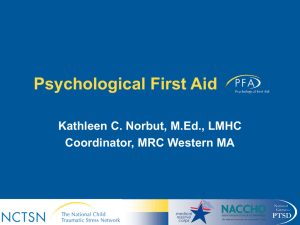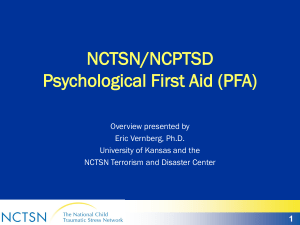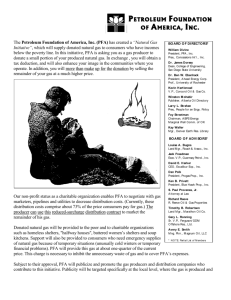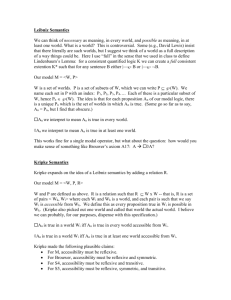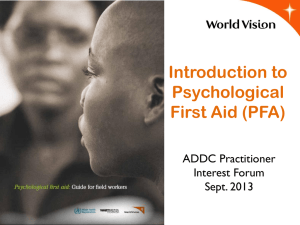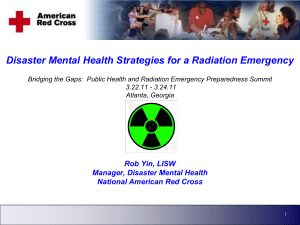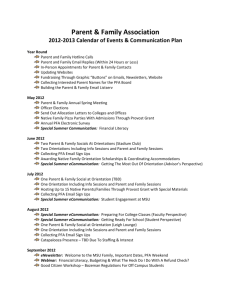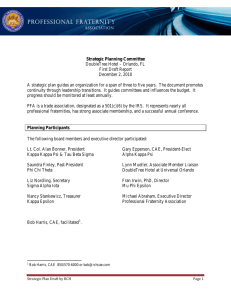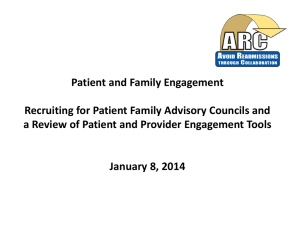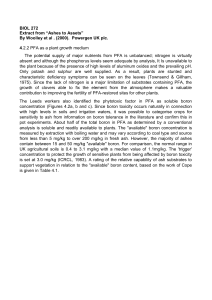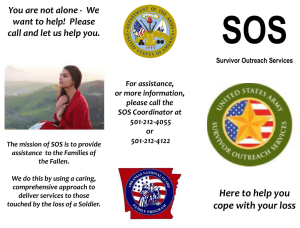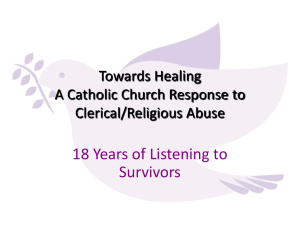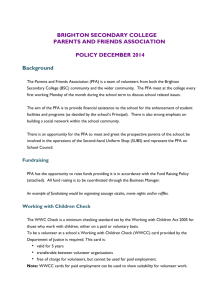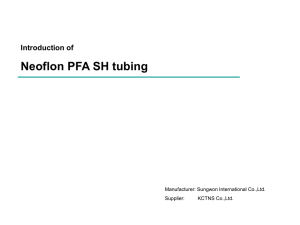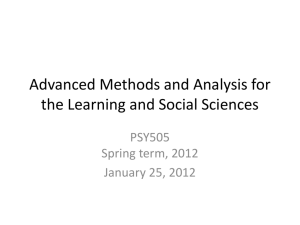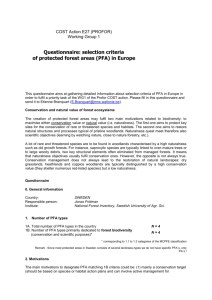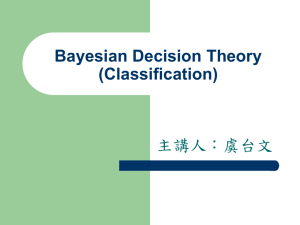Psychological First Aid
advertisement
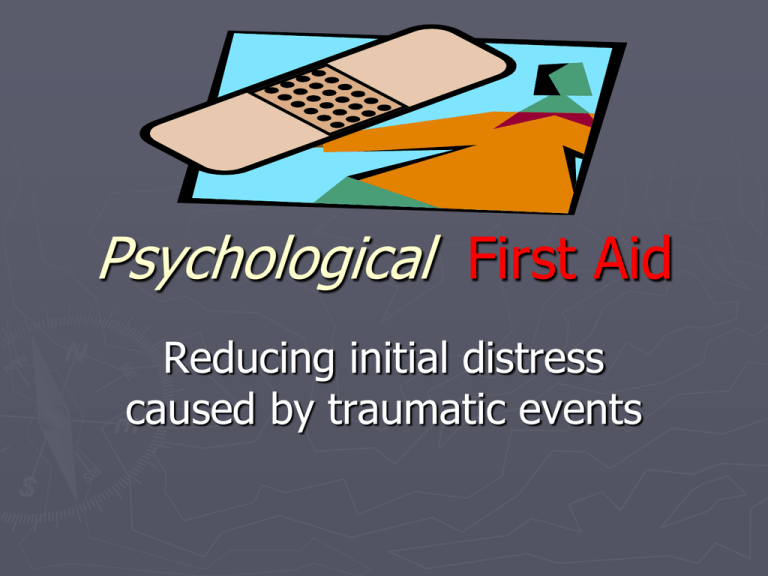
Psychological First Aid Reducing initial distress caused by traumatic events Kelly Morris, MAPC LAC ► ► ► ► ► ► ► Native Arizonan Married (to a firefighter/paramedic) since 1986 Mother of two sons Master of Arts in Professional Counseling Licensed Associate Counselor, State of AZ Resilient Relationships, LLC Therapist, Deer Valley Counseling Information obtained from… ► National Center for PTSD ► National Child Traumatic Stress Network ► Psychological First Aid: Field Operations Guide, 2nd Edition ► International Critical Incident Stress Foundation PFA Online Course PFA vs. Mental Health Triage Mental Health Triage is designed to assess whether a person is likely to have a preexisting mental illness or disorder within the context of an environmental emergency, disaster, etc., and assessing appropriate care. What is PFA? ► Psychological First Aid is an evidenceformed modular approach to help in the immediate aftermath of disaster or terrorism ► Designed to reduce initial distress ► Foster short- and long-term adaptive functioning and coping The Need for PFA ► Over 80% of Americans will be exposed to a traumatic event (Breslau). ► Approximately 9% of those exposed develop PTSD. ► Disasters may create significant impairment in 40-50% of those exposed (Norris, 2001, SAMHSA). Who can deliver PFA? Designed for delivery by mental health and other disaster response workers within a wide variety of response units: First responder teams Health care providers School crisis response teams Faith-based organizations Et. Al. Where should PFA be used? Designed for diverse setting: ► General population shelters ► Special needs facilities (day programs; group homes, etc.) ► Medical triage areas ► Staging areas ► Respite centers for First Responders/Relief Workers Basic Objectives of PFA ► Establish a human connection in a nonintrusive, compassionate manner. ► Enhance immediate & ongoing safety and provide physical & emotional comfort. ► Calm & orient emotionally overwhelmed or distraught survivors. ► Offer practical assistance & information to address immediate needs/concerns. Overview of Core Actions Basic objectives of providing early assistance within days or weeks following an event. Providers should be flexible, and base the amount of time spent on each core action on the survivors’ specific needs and concerns. PFA Core Actions 1. Contact and Engagement – GOAL: To respond to contact initiated by survivors, or initiate contacts in a nonintrusive, compassionate manner. 2. Safety and Comfort Goal: To enhance immediate and ongoing safety, and provide physical and emotional comfort. 3. Stabilization (if needed) Goal: To calm and orient emotionally overwhelmed or disoriented survivors. (Possibly need Mental health triage). 4. Information Gathering Current Needs and Concerns Goal: Identify immediate needs/concerns, gather additional information; tailor PFA interventions. 5. Practical Assistance Goal: To offer practical help to survivors in addressing immediate needs and concerns. 6. Connection with Social Supports Goal: To help establish brief and/or ongoing contacts with primary support persons and other sources of support, including family members, friends, and community helping resources. 7. Information on Coping Goal: To provide information about stress reactions and coping to reduce distress and promote adaptive functioning. 8. Linkage with Collaborative Services Goal: Link survivors with available services needed at the time or in the future. Responders are human, too! ► Approximately 50% of disaster workers are likely to develop significant distress (Meyers & Wee, 2005). ► Terrorism likely to affect majority of population (IOM, 2003); Ranges from 4090%. ► As many as 45% of those directly exposed to mass disasters may develop PTSD or Depression (North, et al., JAMA) Before YOU Begin… Providing care & support in the immediate aftermath of disaster can be an enriching profession and personal experience through helping others. It can also be physically and emotionally exhausting. Consider your current health, family, work circumstances. Personal Considerations Assess your comfort level with the various situations you may experiencing while providing PFA. Working with: ► Individuals who are experiencing intense distress and extreme reactions. ► Individuals in non-traditional settings. ► In a chaotic, unpredictable environment. Personal Considerations, cont. ► Working in an environment with minimal or no supervision…or, conversely, micromanaged. ► Working with and providing support to individuals from diverse cultures, ethnic groups, developmental levels, and faith backgrounds. ► Environments where risk of harm or exposure is not fully known. Personal Health Considerations ► Recent surgeries or medical treatments ► Recent emotional or psychological challenges or problems ► Any significant life changes or losses within the past 6-12 months ► Earlier losses or other negative life events (triggered emotions) Health Considerations, cont. ► Dietary restrictions that may impede work ► Ability to remain active for long periods of time ► Ability to endure physically exhausting conditions ► If needed, enough medication available Family Considerations ► Is your family prepared for your absence? ► Prepared for you to work in environments where risk of harm is unknown? ► Will your support system (family/friends) assume some of your family responsibilities while you are away? Family Considerations, cont. ► Do you have any unresolved family/relationship issues that will make it challenging for you to focus on disasterrelated responsibilities? ► Do you have a strong, supportive environment to return to after your disaster assignment? Personal/Family/Work/Life Plan Take time to prepare for: ► Family & other household responsibilities ► Pet care ► Work responsibilities ► Community activities/responsibilities ► Other responsibilities & concerns During Relief Work In providing PFA, it is important to recognize common and extreme stress reactions, how organizations can reduce the risk of extreme stress to providers, and how best to take care of yourself during your work. Common STRESS Reactions There are a number of common responses when working with survivors: ► Increase/decrease in activity level ► Sleeping difficulties ► Substance use ► Numbing ► Irritability, anger, and frustration Common Stress Reactions, cont. ► Vicarious traumatization in the form of shock, fearfulness, horror, helplessness ► Confusion, lack of attention, difficulty making decisions ► Physical reactions (headaches, stomachaches, being easily startled) ► Depressive or anxiety symptoms EXTREME Stress Reactions ► Compassion stress: helplessness, confusion, isolation. ► Compassion fatigue: demoralization, alienation, resignation. ► Preoccupation or compulsive reexperiencing of trauma experienced either directly or indirectly. Extreme Stress Reactions, cont. ► Attempts to over-control in professional or personal situations ► Withdrawal and isolation ► Preventing feelings by relying on substances, over-preoccupation with work, drastic changes in sleep Extreme Reactions (Wait! There’s More!) ► Serious difficulties in interpersonal relationships, including domestic violence ► Unnecessary risk-taking ► Depression accompanied by hopelessness (which has the potential to place individuals at higher risk for suicide) NO!! DON’T LEAVE!! Provider Self-Care (Proactivity) ► Manage personal resources ► Plan for family/home safety (child care; pet care, etc.) ► Get adequate exercise, nutrition, relaxation Provider Self-Care, cont. Use stress management tools regularly, such as: ► Accessing supervision routinely to share concerns, difficult experiences, and strategizing ► Practice brief relaxation techniques ► Use the buddy system to share upsetting emotional responses ► Stay aware of limitations and needs Self Care, cont. ► Recognize when your are Hungry, Angry, Lonely or Tired (HALT), and take appropriate self-care measures ► Increase activities that are positive ► Practice your faith/philosophy/spirituality Self Care, cont. ► Spend time with family/friends ► Learn how to “put stress away” ► Write/draw/paint ► Limit caffeine, tobacco, and substance use Make every effort to… ► Pace yourself; self-monitor ► Maintain boundaries: delegate, say “no”, avoid working with too many survivors in a given ‘shift’. ► Check in regularly with colleagues, family/friends ► Work with partners Make every effort to… ► Take relaxation/stress management/bodily care/refreshment breaks ► Try to be flexible, patient, and tolerant ► Accept things you cannot change. WIN-WIN Opportunity! Identify, utilize, and maintain self-care now: ► Physical Health ► Mental – Emotional Health ► Relationships (Marriage / family / work) ► Personal Interests (Hobbies, activities, etc.) Your well-being will be enhanced… Favorable Outcome… You will have increased the probability of a favorable outcome of a disaster because you have increased: ► Optimism ► Confidence ► Resources ► Resilience Not only for survivors, but for yourself!
